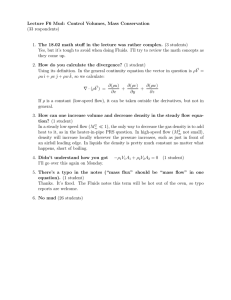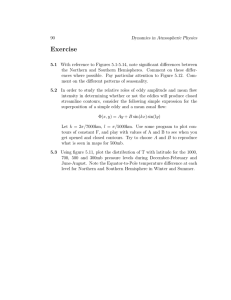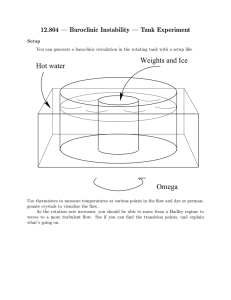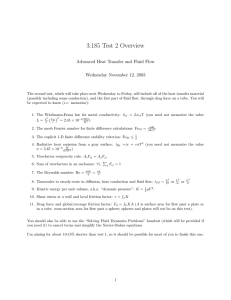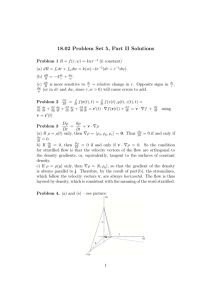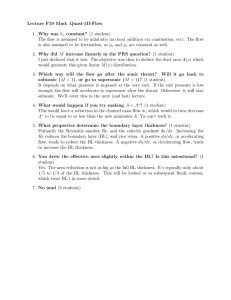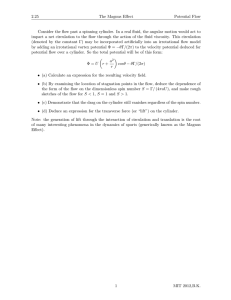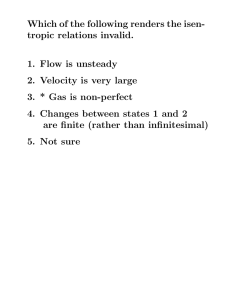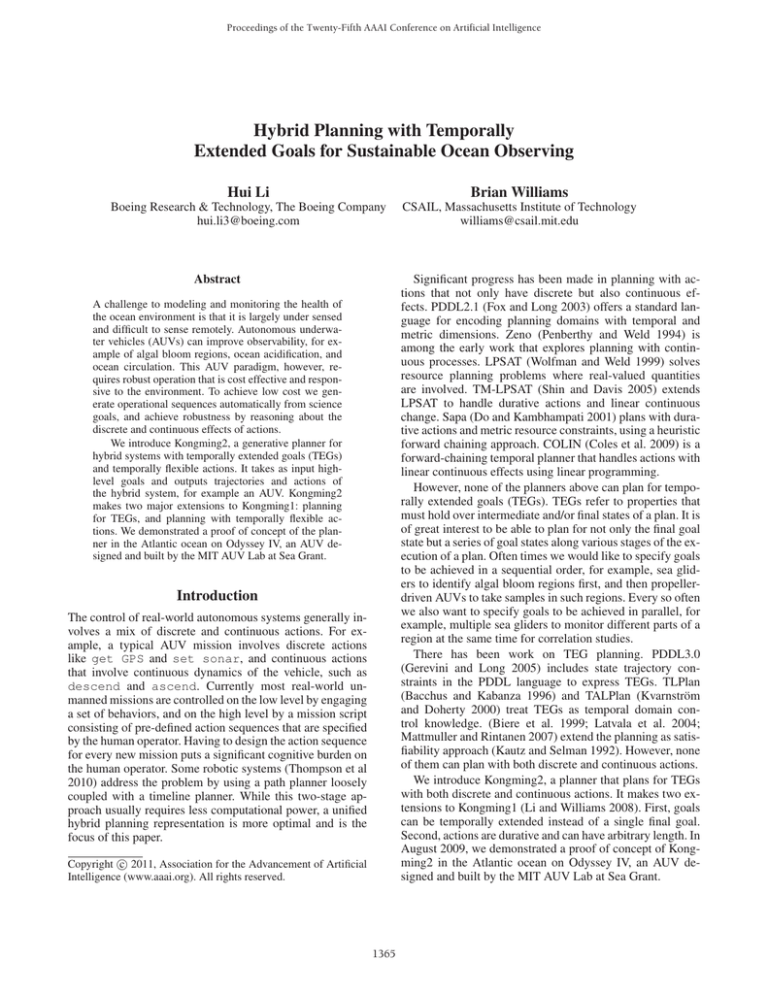
Proceedings of the Twenty-Fifth AAAI Conference on Artificial Intelligence
Hybrid Planning with Temporally
Extended Goals for Sustainable Ocean Observing
Hui Li
Brian Williams
Boeing Research & Technology, The Boeing Company
hui.li3@boeing.com
CSAIL, Massachusetts Institute of Technology
williams@csail.mit.edu
Significant progress has been made in planning with actions that not only have discrete but also continuous effects. PDDL2.1 (Fox and Long 2003) offers a standard language for encoding planning domains with temporal and
metric dimensions. Zeno (Penberthy and Weld 1994) is
among the early work that explores planning with continuous processes. LPSAT (Wolfman and Weld 1999) solves
resource planning problems where real-valued quantities
are involved. TM-LPSAT (Shin and Davis 2005) extends
LPSAT to handle durative actions and linear continuous
change. Sapa (Do and Kambhampati 2001) plans with durative actions and metric resource constraints, using a heuristic
forward chaining approach. COLIN (Coles et al. 2009) is a
forward-chaining temporal planner that handles actions with
linear continuous effects using linear programming.
However, none of the planners above can plan for temporally extended goals (TEGs). TEGs refer to properties that
must hold over intermediate and/or final states of a plan. It is
of great interest to be able to plan for not only the final goal
state but a series of goal states along various stages of the execution of a plan. Often times we would like to specify goals
to be achieved in a sequential order, for example, sea gliders to identify algal bloom regions first, and then propellerdriven AUVs to take samples in such regions. Every so often
we also want to specify goals to be achieved in parallel, for
example, multiple sea gliders to monitor different parts of a
region at the same time for correlation studies.
There has been work on TEG planning. PDDL3.0
(Gerevini and Long 2005) includes state trajectory constraints in the PDDL language to express TEGs. TLPlan
(Bacchus and Kabanza 1996) and TALPlan (Kvarnström
and Doherty 2000) treat TEGs as temporal domain control knowledge. (Biere et al. 1999; Latvala et al. 2004;
Mattmuller and Rintanen 2007) extend the planning as satisfiability approach (Kautz and Selman 1992). However, none
of them can plan with both discrete and continuous actions.
We introduce Kongming2, a planner that plans for TEGs
with both discrete and continuous actions. It makes two extensions to Kongming1 (Li and Williams 2008). First, goals
can be temporally extended instead of a single final goal.
Second, actions are durative and can have arbitrary length. In
August 2009, we demonstrated a proof of concept of Kongming2 in the Atlantic ocean on Odyssey IV, an AUV designed and built by the MIT AUV Lab at Sea Grant.
Abstract
A challenge to modeling and monitoring the health of
the ocean environment is that it is largely under sensed
and difficult to sense remotely. Autonomous underwater vehicles (AUVs) can improve observability, for example of algal bloom regions, ocean acidification, and
ocean circulation. This AUV paradigm, however, requires robust operation that is cost effective and responsive to the environment. To achieve low cost we generate operational sequences automatically from science
goals, and achieve robustness by reasoning about the
discrete and continuous effects of actions.
We introduce Kongming2, a generative planner for
hybrid systems with temporally extended goals (TEGs)
and temporally flexible actions. It takes as input highlevel goals and outputs trajectories and actions of
the hybrid system, for example an AUV. Kongming2
makes two major extensions to Kongming1: planning
for TEGs, and planning with temporally flexible actions. We demonstrated a proof of concept of the planner in the Atlantic ocean on Odyssey IV, an AUV designed and built by the MIT AUV Lab at Sea Grant.
Introduction
The control of real-world autonomous systems generally involves a mix of discrete and continuous actions. For example, a typical AUV mission involves discrete actions
like get GPS and set sonar, and continuous actions
that involve continuous dynamics of the vehicle, such as
descend and ascend. Currently most real-world unmanned missions are controlled on the low level by engaging
a set of behaviors, and on the high level by a mission script
consisting of pre-defined action sequences that are specified
by the human operator. Having to design the action sequence
for every new mission puts a significant cognitive burden on
the human operator. Some robotic systems (Thompson et al
2010) address the problem by using a path planner loosely
coupled with a timeline planner. While this two-stage approach usually requires less computational power, a unified
hybrid planning representation is more optimal and is the
focus of this paper.
c 2011, Association for the Advancement of Artificial
Copyright Intelligence (www.aaai.org). All rights reserved.
1365
Hybrid Planning with TEGs
in different stages of the action: start, overall, and end. Dynamics describe the state transition and the actuation limits of a system when performing an action. Actions have
flexible durations. Each duration is a real-valued variable
bounded by a lower bound and an upper bound. We show
two action examples in Fig. 2 for the underwater domain.
We first define the input and output of the planner.
Problem Statement
Kongming2 takes as input a set of state variables, control variables, initial conditions, temporally extended goals
(TEGs), hybrid durative action types, external constraints,
and an objective function. It outputs an optimal sequence of
actions and state trajectory from the given action types that
achieve the TEGs without violating any of the constraints.
We next define each item.
The state variables, s, represent the continuous and discrete state of the system. s = x, p, where x ∈ n is a
vector of real-valued variables, and p is a vector of propositional variables.
The control variables, u, represent the control input to the
system. u ∈ m is a vector of real-valued control variables,
u = u1 , u2 , . . . , um .
The initial conditions, I, specify constraints on the initial
value of the state variables s. I = (Ax ≤ b) ∧i li , where
Ax ≤ b is a system of linear inequalities over x, and each li
is a positive or negative literal for pi ∈ p.
We define the set of temporally extended goals (TEGs)
as a qualitative state plan (QSP), which specifies the desired
state trajectory of the system under control. It consists of the
following.
(:durative-action descend
:condition ((start (rudder))
(overall (rudder)))
:discrete-effect ()
:dynamics (u [ulb , uub]
(:durative-action take-sample
:parameter (?r - region)
:condition ((start((x,y,z)?r)(gulper)(¬sample))
(overall((x,y,z)?r)(gulper))
(end((x,y,z)?r)))
x(ti+1) = Ax(ti) + Bu(ti)) :discrete-effect (end(sample))
:dynamics ()
:duration (d [0, +)))
:duration (d [2, 5]))
Figure 2: Action descend requires rudder to be on at the
start and during the action. It has no discrete effect. Its dynamics are governed by the bounds and equation. Its duration is unlimited. Similar with action take-sample. The
main differences are its dynamics are unspecified and its discrete effect is there is sample at the end.
External constraints, impose external requirements on the
state of the system under control. They are in conjunctive
normal form (CNF), and are specified by a conjunction of
clauses, each of which is a disjunction of linear inequalities
over the state variables x.
The objective function is a linear or quadratic function
over real-valued state variables x, control variables u, and
time. Typical objective functions are to minimize battery
use, distance traveled, or mission completion time.
The output is an optimal hybrid plan, consisting
of a sequence of durative actions, control inputs, and
the resulting states. The sequence of control inputs
{u∗ (t1 ), u∗ (t2 ), . . . , u∗ (tN −1 )} is an optimal assignment
to the control variables u, and u∗ (ti ) is the assignment to u at time ti . The sequence of states
{s∗ (t1 ), s∗ (t2 ), . . . , s∗ (tN )} is an optimal assignment to the
continuous and discrete state variables s = x, p, and
s∗ (ti ) is the assignment to s at time ti . Part of the output
is shown in the example in Fig. 3, namely, the sequence of
continuous states and actions.
• A finite set of events, each representing a point in time.
• A finite set of episodes that specify the desired state evolution over time. Each episode has a start event, an end
event, and a state constraint over the state variables.
• A finite set of temporal constraints that specify the lower
and upper temporal bounds between two events.
Fig. 1 shows a QSP example of an ocean observing
mission. It consists of three events, shown as nodes, two
episodes, specifying the goal states, and temporal bounds
between events. Episode ep1 requires samples taken in region A and B at depth 16m at the end of the episode. It
should take between 30 and 45 time units to achieve this
episode.
Ascend
[30, 45]
[40, 65]
ep1
ep2
E: sample taken in
A & B at 16m
ev1
ev2
[0, 100]
E
D
C
Waypoint
B
A
E: sample taken in
C, D & E at 20 m
ev3
Figure 1: QSP example. Events are ev1 , ev2 and ev3 .
Episodes are ep1 and ep2 . Temporal bounds are specified
between events.
Descend
Take sample
Figure 3: In a segment of the ocean. We show the state trajectory and action sequence of the planner output. The solid
blue line represents the trajectory. Continuous and discrete
actions take place along the trajectory.
Hybrid durative action types specify conditions, discrete
effects, dynamics and duration of the action types that a system can perform. Conditions are requirements that must be
satisfied in order for an action to take place. Discrete effects
capture the changed propositional truth values as a result of
the action. Both conditions and discrete effects are specified
Next we introduce the approach, starting with a review of
Kongming1 (Li and Williams 2008). We then introduce the
1366
two extensions in Kongming2 for TEGs and for temporally
flexible actions.
Similar to a Planning Graph, in a Hybrid Flow Graph, two
action nodes, either continuous or discrete, at a given action
level are marked as mutually exclusive (mutex) if no valid
plan could contain both. Likewise, two facts at a given fact
level are mutex if no valid plan could satisfy both. Different
from Graphplan are the exclusion rules that involve continuous facts or continuous actions.
Kongming1 then encodes the Hybrid Flow Graph as an
MLLP, based on a series of encoding rules. The rules are
analogous to those for Blackbox (Kautz and Selman 1999),
which encodes a Planning Graph as a SAT problem. The
main difference from Blackbox is the introduction of continuous variables and constraints.
Review of Kongming1
Kongming1 employs a compact representation of all hybrid plans, called a hybrid flow graph, which combines the
strengths of a Planning Graph for discrete actions and Flow
Tubes for continuous actions. It then encodes the hybrid flow
graph as a mixed logic linear program (MLLP), which it
solves using CPLEX, an off-the-shelf solver.
c = f(Ri, d, bounds)
Hybrid action a
preconditions:
•
–
–
•
•
continuous: i fi (s) 0
discrete: j p j
Extension 1: Temporally Extended Goals
Ri
c
s
dynamics:
– state equation
– bounds
effects: j p j
We extend Kongming1 to plan for TEGs. This enables us to
specify requirements along various stages of the execution
of a plan, rather than only in the final stage. As defined in
the problem statement, the TEGs are in the form of a QSP.
Our approach is based on the novel idea that each episode in
the QSP can be achieved through enforcing the conditions
of a “pseudo” action. We create a hybrid durative action for
each episode in a QSP. The conditions of the action include
all the state constraints of the episode. In order to make the
effects of the action true, the conditions have to be satisfied,
which enforces the state constraints to be achieved.
An example of a QSP is shown on the left of Fig. 6. We
observe that episodes in a QSP are similar to hybrid durative
actions in that they are durative, and have constraints specified at the start, over the duration, and at the end. An encoding that represents episodes as durative actions may be used.
The main difference is that episodes establish conditions to
be satisfied, while actions establish effects to be produced.
In addition, a QSP specifies which episodes precede and follow other episodes, while there is no specific description on
how durative action types are ordered.
Fig. 6 shows the reformulation of one episode in a QSP
into an action. Let us focus on episode ep2 in the QSP on
the left of the figure. The right of the figure shows the action created for episode ep2 . The duration of the action is
bounded by the simple temporal constraint on the start and
end events of the episode, if there is any. The conditions of
the action include the state constraints of the episode, and the
fact that all predecessors of the episode have been achieved.
The discrete effect of the action at the end is the fact that this
episode has been achieved. Dynamics are unspecified.
We explain the reformulation procedure as follows.
d
Figure 4: Mapping from a continuous action to a flow tube.
The intersection of the current state with the continuous precondition of the action forms the initial region of the flow
tube Ri . c is the end region of the flow tube, which is a function of Ri , duration d and dynamic bounds.
Flow tubes are used to as an abstraction of an infinite
number of trajectories of continuous actions. A flow tube is
a collection of all trajectories going from an initial region to
the end region, which is a function of the initial region, duration and dynamic bounds. Each continuous action can be
modeled as a flow tube, as shown in Fig. 4. Two flow tubes
are connected when the continuous precondition of the second flow tube intersects with the end region of the first flow
tube, as shown in Fig. 5.
x
Rg2
Ri2
a2
Rg1
Ri1
a1
d1
a2 continuous
precondition
d2
t
Figure 5: Connecting one flow tube to another.
Hybrid Flow Graphs build upon Planning Graphs introduced by Graphplan (Blum and Furst 1997), augmented with
flow tubes, to represent all valid plans and collections of feasible state trajectories. A hybrid flow graph is a directed, leveled graph that alternates between fact levels and action levels. A fact level contains two types of fact nodes: continuous
fact nodes and discrete fact nodes. An action level contains
hybrid action nodes, and each node can be either continuous
or discrete. When continuous dynamics are not involved, a
hybrid action is discrete. Otherwise it is continuous and is
denoted by a flow tube, connecting an initial region and an
end region over a duration.
• A hybrid durative action type a is created for every
episode ep in the QSP.
• If there exists a simple temporal constraint in the QSP on
the time between the start event and the end event of the
episode, then the duration of a is bounded by the lower
and upper bounds in the temporal constraint. Otherwise,
the duration of a is unbounded, specified as [0, +∞).
• The state constraints of ep are encoded as the conditions
of a. More specifically, the start constraints of ep are encoded as the start conditions of a; the overall constraints
1367
[lb2, ub2]
:duration d [lb2, ub2]
Overall: co1
:condition (and
(start (cs2)(ep1-ended))
Start: cs2
ep1
Start: cs1
ev1
Overall: co2
ev2
End: ce1
End: ce2
are added at the start, in the middle and at the end of the flow
tube.
(:durative-action a2
ep2
ev3
(overall (co2))
ep3
x
(end (ce2)))
Start: cs3
Overall: co3
End: ce3
[lb1, ub1]
:discrete-effect (and
(start ())
(overall ())
(end (ep2-ended)))
:dynamics ())
cond-start
eff-start
cond-int
eff-int
(:durative-action A
:duration d [dlb , dub]
cond-end
eff-end
cs(RI ,d)
RI
Figure 6: Hybrid durative action type a2 is created for
episode ep2 . ep1 -ended and ep2 -ended are literals, representing respectively the fact that ep1 and ep2 are achieved.
cs2 , co2 and ce2 are the constraints at different times of ep2 .
dlb
t
d
dub
:condition (and
(start (cond-start))
(overall (cond-int))
(end (cond-end)))
:discrete-effect (and
(start (eff-start))
(overall (eff-int))
(end (eff-end)))
:dynamics (and
(u [ulb , uub])
(xi+1 = Axi + Bui)))
Figure 7: The specification of a hybrid durative action is
listed on the right. Its flow tube representation is on the
left. cond-start represents the start conditions; cond-int represents the overall conditions; cond-end represents the end
conditions. eff-start represents the start discrete effects; likewise for eff-int and eff-end. The duration of the action is flexible. The start, overall and end conditions are checked at the
start, in the middle and at the end of the flow tube. The start,
overall and end discrete effects are added at the start, in the
middle and at the end of the flow tube.
of ep are encoded as the overall conditions of a; and the
end constraints of ep are encoded as the end conditions.
• Another start condition of a requires that all the predecessors of ep have been achieved. Naturally, an episode
cannot be started if any of its predecessors have not completed.
• The only discrete effect of a is that ep has completed,
specified by a literal ep-ended. This effect is the end effect, because naturally, before the end of an episode, it
cannot be considered completed. The start and overall effects of a are empty.
We encode each hybrid durative action as a set of atomic
actions, by “slicing” the flow tube into multiple pieces. All
flow tube slices have the same duration, Δt. We do not
adopt the continuous timeline in LPGP because we need to
keep the constraints in the mixed logic quadratic program
encoding linear. When both the control input and duration
are variables, non-linear constraints are introduced. This is
because the state equations need to be satisfied in each action level. For example, a simple first-order state equation:
x(ti ) = x(ti−1 ) + ẋ(ti−1 ) × (ti − ti−1 ). The two terms in
the product, ẋ(ti−1 ) and (ti − ti−1 ), can’t both be variable.
We discuss the alternative at the end of the paper.
We combine the flow tube slices with the LPGP encoding,
to ensure that first, the conditions at various stages are enforced at the beginning of each flow tube slice; second, the
effects at various stages are added at the end of each flow
tube slice; and finally, the start flow tube slice is performed
first, followed by one or more intermediate flow tube slices,
and ending with the end flow tube slice.
As shown on the left of Fig. 8, the flow tube is divided
into multiple flow tube slices, each having duration Δt. As
shown on the right of Fig. 8, the flow tube slices are combined with the LPGP encoding. More specifically, the first
flow tube slice corresponds to atomic action A-start. The
last flow tube slice corresponds to atomic action A-end. The
flow tube slices in the middle correspond to atomic action
A-int. The duration for all the atomic actions is Δt. Moreover, the atomic actions all keep the same dynamics as in the
durative action.
This encoding of a hybrid durative action not only discretizes the flow tube into slices with length of Δt each, but
also uses the conditions of the action type at different stages
to prune the invalid regions in state space and hence invalid
trajectories in the flow tube.
• The dynamics of a are unspecified, because the actions
are “pseudo” actions that do not produce any actual effects. They are created to enforce the state constraints of
episodes in the QSP.
• The final goal state requires that all episodes in the QSP
are achieved, specified by ∧i epi -ended, ∀epi ∈ qsp.
This reformulation procedure can be adopted by PDDL
planners. If one chooses to represent the TEGs as a QSP,
then the procedure remains unchanged, except that the step
about dynamics is removed. If an MITL-type (Alur et al
1996) representation is used, (Li 2010) shows that any nondisjunctive MITL can be expressed in QSP.
Extension 2: Flexible Action Durations
The second extension to Kongming1 is allowing actions to
be durative and have flexible durations. Our approach builds
upon LPGP (Long and Fox 2002), which encodes each discrete durative action as a start, an end and one or more intermediate actions. Kongming2 combines the LPGP encoding with flow tubes to reformulate hybrid durative actions as
hybrid atomic actions. Because the LPGP encoding only applies to actions with discrete conditions and effects, the main
challenge lies in incorporating the flow tubes of the hybrid
actions in the encoding.
Fig. 7 shows a simple flow tube representation of a hybrid
durative action with flexible duration. The specification of
a hybrid durative action is listed on the right. Its flow tube
representation is on the left. The start, overall and end conditions are checked at the start, in the middle and at the end
of the flow tube. The start, overall and end discrete effects
1368
reaching three waypoints before going to the pickup point.
The graphical user interface used by Kongming2 for the scenario is shown in Fig. 10. As we can see, an obstacle prevents Odyssey IV from following a straight line from waypoint 2 to 3. The obstacle is imaginary in the ocean.
t
x
t
t
t
t
t
t
t
t
t
t
A-start
A-int
A-int
A-int
A-end
Durative action A
Figure 8: Kongming2 combines the flow tube slices with the
LPGP encoding. On the left, the flow tube of a hybrid durative action is divided into slices, each with length Δt. On the
right, the flow tube slices are combined with the LPGP encoding. The blue line represents the continuous condition of
A-start. The red lines represent the continuous condition of
A-int. The green line represents the continuous condition of
A-end. The initial region of a flow tube slice is the intersection of the continuous condition of its corresponding atomic
action and the end region of its previous flow tube slice.
Figure 10: Display of the graphical user interface for the scenario. The mission requires Odyssey IV to reach three waypoints before going to the pickup point. There is an obstacle
between Waypoint 2 and 3.
Proof of Concept on An AUV
The QSP input to Kongming2 is shown in Fig. 11. Two
episodes, ep3 and ep4 , to reach the obstacle corners are
added. The initial condition for Kongming2 is to be at the
start point, as seen in Fig. 10. The objective function is a
quadratic function to minimize the total distance traveled.
We ran Kongming2 on Odyssey IV (Fig. 9) in the Atlantic
ocean in Cape Cod. One of the main goals of the demonstration was to show Kongming2’s capability of producing
optimal hybrid plans to achieve temporally extended goals.
Another important goal of the demonstration was to show
Kongming2’s capability of generating mission scripts that
run seamlessly on an AUV in a natural environment. Prior to
this field demonstration, Odyssey IV and other AUVs at the
MIT AUV Lab had only been controlled by mission scripts
written by the engineers. Kongming2 automatically generates optimal mission scripts, and enables cost effective and
robust operations.
ep1 [1,200]
e1
ep2 [1,100]
Start:
Overall:
End: at Waypoint 1
e2
ep6 [1,300]
e7
Start:
Overall:
End: at Pickup Point
ep3 [1,100]
Start:
Overall:
End: at Waypoint 2
e3
ep5 [1,100]
e6
Start:
Overall:
End: at Waypoint 3
Start:
Overall:
End: at Corner 1
ep4 [1,100]
e5
Start:
Overall:
End: at Corner 2
e4
Figure 11: The QSP for the test. Each episode in the QSP
specifies the state of reaching a waypoint. The temporal constraint for each episode is specified in square brackets.
Figure 9: Odyssey IV, an AUV from the MIT AUV Lab at
Sea Grant, is 0.7 × 1.4 × 2.2m, weighs 500kg dry and about
1000kg wet, and has rated depth 6000m.
Assumed start point
Actual start point
As this was our first field demonstration, although Kongming2 is fully capable of planning in 3D, for safety reasons,
the vehicle was kept on the surface, in order to maintain constant communication. As the vehicle was limited to operate
on the surface, this reduced planning to one continuous action type, namely GoToWaypoint. Moreover, at the time
of the demonstration, the vehicle could not perform any discrete action, so GoToWaypoint was the only hybrid action
type available for the field demonstration.
We conducted two major tests. Due to limited space in
the paper, we describe one of them. The scenario consists of
Figure 12: The plot of the actual trajectory of Odyssey
IV executing the mission script generated by Kongming2.
AUV’s trajectory is in blue dots, and the waypoints planned
by Kongming2 are in red crosses.
The mission script generated by Kongming2 consists of
22 action instances, and can be found in (Li 2010). The mission script commands Odyssey IV to go to the waypoints
1369
specified in the QSP as well as all the intermediate waypoints generated by Kongming2. The behavior-based controller of the vehicle then maneuvers it to those waypoints
within specified time bounds. The trajectory of the vehicle is
shown in Fig. 12, where the wavy parts were due to currents
in the ocean and the fact that the controller was under-tuned.
The extra leg close to the bottom of the plot occurs because
at the start of the mission, the vehicle was not at the assumed
start location. Hence the controller had to maneuver the vehicle to the assumed start location first, which was not part
of the plan Kongming2 output.
F. Bacchus and F. Kabanza 1996. Planning for Temporally Extended Goals. In Proceedings of AAAI.
A. Biere and A. Cimatti and E. Clarke and Y. Zhu 1999. Symbolic
Model Checking without BDDs. In Proceedings of TACAS.
A. Blum and M. Furst 1997. Fast planning through planning graph
analysis. Artificial Intelligence.
A. J. Coles and A. I. Coles and M. Fox and D. Long 2009. Temporal Planning in Domains with Linear Processes. In Proceedings of
International Joint Conference on Artificial Intelligence (IJCAI).
M. B. Do and S. Kambhampati 2001. Sapa: A DomainIndependent Heuristic Metric Temporal Planner. In Proceedings
of European Conference on Planning (ECP).
M. Fox and D. Long 2003. PDDL2.1: An Extension of PDDL
for Expressing Temporal Planning Domains. Journal of Artificial
Intelligence Research.
E. Frazzoli 2001. Robust Hybrid Control for Autonomous Vehicle
Motion Planning. PhD Thesis, MIT.
A. Gerevini and D. Long 2005. Plan constraints and preferences in
PDDL3 - the language of the fifth international planning competition. Technical Report, Department of Electronics for Automation,
University of Brescia, Italy.
M. Greytak 2009. Integrated Motion Planning and Model Learning for Mobile Robots with Application to Marine Vehicles. PhD
Thesis, MIT.
H. Kautz and B. Selman 1992. Planning as Satisfiability. In Proceedings of European Conference on Artificial Intelligence (ECAI).
H. Kautz and B. Selman 1999. Unifying SAT-based and Graphbased Planning. In Proceedings of International Joint Conference
on Artificial Intelligence (IJCAI).
J. Kvarnström and P. Doherty 2000. TALPlanner: A Temporal
Logic based Forward Chaining Planner. Annals of Mathematics
Artificial Intelligence.
T. Latvala and A. Biere and K. Heljanko and T. Junttila 2004. Simple Bounded LTL Model Checking. In Proceedings of FMCAD.
H. Li and B. Williams 2008. Generative Planning for Hybrid Systems based on Flow Tubes In Proceedings of International Conference on Automated Planning and Scheduling (ICAPS).
H. Li 2010. Kongming: A Generative Planner for Hybrid Systems
with Temporally Extended Goals. PhD Thesis. MIT.
D. Long and M. Fox 2002. Fast Temporal Planning in a Graphplan Framework. In Proceedings of International Conference on
Automated Planning and Scheduling (ICAPS).
R. Mattmuller and J. Rintanen 2007. Planning for Temporally
Extended Goals as Propositional Satisfiability. In Proceedings of
International Joint Conference on Artificial Intelligence (IJCAI).
J. Penberthy and D. Weld 1994. Temporal Planning with Continuous Change. In Proceedings of AAAI.
T. Schouwenaars and B. Mettler and E. Feron and J. How 2003.
Robust Motion Planning Using a Maneuver Automaton with Builtin Uncertainties. In Proceedings of ACC.
J. Shin and E. Davis 2005. Processes and Continuous Change in a
SAT-based Planner. Artificial Intelligence.
D. Thompson and S. Chien and Y. Chao and P. Li and B. Cahill
and J. Levin and O. Schofield and A. Balasuriya and S. Petillo and
M. Arrott and M. Meisinger 2010. Spatiotemporal path planning
in strong, dynamic, uncertain currents. In Proceedings of IEEE
International Conference on Robotics and Automation (ICRA).
S. Wolfman and D. Weld 1999. The LPSAT Engine and Its Application to Resource Planning. In Proceedings of International Joint
Conference on Artificial Intelligence (IJCAI).
Evaluation and Discussion
We empirically evaluated Kongming2 in both the underwater domain and the air vehicle domain. We describe two main
results here. Please refer to (Li 2010) for details. First, Kongming2 scales better in terms of the number of discrete action types than in terms of the number of continuous action
types. The reason is that in each action level, for one continuous action type, there can be a large number of flow tubes
based on different initial regions, which then propagate to a
large number of continuous facts in the next fact level, and
so on. Second, the time discretization factor Δt significantly
affects the computation time of Kongming2, as it decides the
number of levels in the Hybrid Flow Graph.
Because in Kongming2 the control input of each action
is a variable, we have to discretize time in order to keep
the dynamical equations linear. This discretization of time
makes the approach less scalable. An alternative is to keep
time continuous and discretize control input. The Maneuver Automaton (Frazzoli 2001; Schouwenaars et al 2003;
Greytak 2009) is a representation of the discretized dynamics of a vehicle, consisting of a finite collection of two types
of motion primitives: trim conditions and maneuvers. Trim
conditions are similar to the hybrid action types in Kongming2, except that each trim condition has a fixed control
value. For vehicles whose dynamics can be approximated
with a reasonable number 1 of trim conditions, Maneuver
Automata may provide a more computationally efficient solution to continuous-time planning.
Conclusion
In this paper, we introduce Kongming2, a planner that plans
for TEGs with both discrete and continuous actions that
are temporally flexible. We focus on the two extensions to
Kongming1. First, goals can be temporally extended instead
of a single final goal. Second, actions are durative and can
have arbitrary length. We demonstrated a proof of concept
of Kongming2 on an AUV in the Atlantic ocean. It opens up
possibilities of robust and cost effective AUV paradigm for
ocean observing.
References
R. Alur and T. Feder and T. Henzinger 1996. The benefits of
relaxing punctuality. Journal of the ACM.
1
The examples in (Frazzoli 2001; Schouwenaars et al 2003;
Greytak 2009) are on the order of 10 trim conditions.
1370

